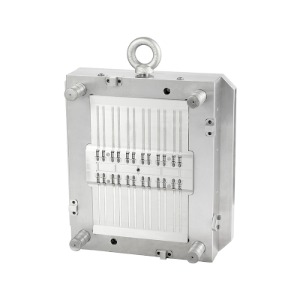 2025.09.19
2025.09.19
 News
News
Automotive cable tie molds are essential tools in the production of cable management solutions for vehicles. Cable ties help organize wires, prevent tangling, and enhance safety and efficiency in automotive electrical systems. The molds used to manufacture these cable ties play a crucial role in determining the quality, durability, and precision of the final product.

Automotive cable tie molds are important because they directly affect the quality and consistency of cable ties. High-quality molds ensure that the ties meet exact specifications, including strength, flexibility, and size uniformity. In the automotive industry, cable ties must withstand vibrations, temperature changes, and exposure to oils or chemicals, making mold selection critical. Properly designed molds also improve production efficiency by reducing cycle time, material waste, and maintenance requirements.
Key Characteristics of Automotive Cable Tie Molds
Several characteristics define the performance and suitability of cable tie molds:
1. Material Quality
The material used for the mold is a key factor in durability and performance. Common materials include P20, H13, and stainless steel. P20 steel is ideal for high-volume production due to its toughness and wear resistance. H13 steel offers heat resistance and durability, suitable for complex designs and longer production runs. Stainless steel provides corrosion resistance for molds exposed to moisture or chemicals.
2. Mold Design Complexity
Cable tie molds can range from simple single-cavity molds to multi-cavity molds designed for mass production. Simple molds are suitable for standard cable ties, while multi-cavity or intricate molds are used for specialized designs, such as ratchet-style ties or ties with unique locking mechanisms. The complexity of the mold affects production speed, precision, and maintenance requirements.
3. Precision and Tolerance
Automotive cable ties require precise dimensions and consistent quality. High-precision molds maintain tight tolerances, ensuring that the ties fit securely and function properly. Accurate molds prevent defects such as weak locking mechanisms, inconsistent lengths, or deformed ties, which could compromise safety or performance in automotive applications.
4. Surface Finish
The surface finish of a mold affects the appearance and smoothness of cable ties. Polished mold surfaces produce smooth, glossy ties, while textured molds can add grip or decorative effects. A well-finished mold improves both the visual appeal and functional performance of the cable ties.
5. Cooling and Ejection Systems
Efficient cooling channels in the mold reduce cycle time and improve dimensional accuracy. Proper ejection systems, such as pins or plates, ensure that the finished cable ties are removed smoothly without deformation or damage. These systems enhance production efficiency and reduce the risk of defects.
6. Longevity and Maintenance
Durable molds with proper maintenance can produce thousands of cable ties with minimal wear. Regular cleaning, lubrication, and inspection of critical components help maintain mold performance and extend service life.
Types of Automotive Cable Tie Molds
Automotive cable tie molds can be categorized based on cavity design, functionality, and production capacity:
Single-Cavity Molds: Produce one cable tie per cycle, ideal for small-scale production or prototype testing.
Multi-Cavity Molds: Produce multiple cable ties simultaneously, suitable for mass production with higher efficiency.
Standard Molds: Produce basic cable ties with uniform size and standard locking mechanisms.
Specialty Molds: Designed for unique or custom cable ties, such as adjustable-length ties, colored ties, or ties with integrated labeling areas.
Comparisons of Automotive Cable Tie Molds
When comparing different types of molds, several factors are noteworthy:
Production Volume: Multi-cavity molds are ideal for high-volume manufacturing, while single-cavity molds suit small-scale or prototype production.
Design Flexibility: Specialty molds accommodate custom cable tie designs, whereas standard molds produce uniform, general-purpose ties.
Precision and Quality: High-precision molds produce consistently strong and functional ties, important for automotive applications.
Maintenance Requirements: Simpler molds are easier to maintain, while complex molds may require more attention and skilled handling.
Cost Efficiency: Multi-cavity molds offer lower per-unit production costs, while single-cavity or specialty molds may have higher upfront costs but allow for design experimentation.
How to Choose an Automotive Cable Tie Mold
Choosing the right mold involves evaluating production needs, design requirements, and operational efficiency:
Determine Production Volume: High-volume production benefits from multi-cavity molds, while small batches may use single-cavity molds.
Assess Design Complexity: Choose standard molds for uniform cable ties and specialty molds for customized or innovative designs.
Consider Material Durability: Select steel or stainless steel molds based on production frequency, expected wear, and environmental conditions.
Evaluate Precision Needs: High-precision molds ensure consistent tie dimensions and reliable performance in automotive applications.
Review Maintenance and Lifespan: Choose molds that can be easily maintained and deliver long-term reliability to reduce downtime and costs.